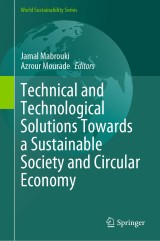Details
Technical and Technological Solutions Towards a Sustainable Society and Circular Economy
World Sustainability Series
|
213,99 € |
|
| Verlag: | Springer |
| Format: | |
| Veröffentl.: | 13.05.2024 |
| ISBN/EAN: | 9783031562921 |
| Sprache: | englisch |
Dieses eBook enthält ein Wasserzeichen.
Beschreibungen
<p>Resource depletion and ecological risks are more than ever at the heart of societal and economic debates. In the 1970s, the developed countries saw the Fordist growth regime crumble in parallel with the growing awareness of the ecological issue. Since the first industrial revolutions, technological dynamics have been the cause of many environmental problems, and there is a consensus on the diagnosis. Integrated technologies reduce resource use and/or pollution at source by using cleaner production methods. This generally leads to a reduction in the by-products, energy inputs and resources used by companies to produce goods.</p><p>Integrated production technologies reduce negative environmental impacts at source by substituting or modifying cleaner technologies. Examples of integrated, or cleaner, production technologies are the recirculation of materials, the use of environmentally friendly materials (such as the substitution of water for organic solvents), etc. However, the implementation of integrated production technologies is often hampered by obstacles related to cost, coordination and skill inertia problems and to the productive organisation of companies. In addition to the high investment costs of new integrated technologies, additional barriers may emerge depending on the nature of the environmental problem and the type of environmental regulation in question.</p>
<p>Chapter 1. Assessment of land cover change impacts (1987-2022) over environmental degradation using NDVI index and GIS tools within upstream part of Oum Err Bia basin (Morocco) (Halouan Said).- Chapter 2. Use of biological parameters of Mytilus galloprovincialis and modelling investigation tools for installing potential future zones of mussel farming after improvement of Anza-Taghazout seawater quality (Youssef El Mourabit).- Chapter 3. Building a Greener World: Harnessing the Power of IoT and Smart Devices for Sustainable Environment (Wasswa Shafik).- Chapter 4. The application of solar distillation technology as a sustainable solution for seawater desalination in the arid regions of the world (Souad NASRDINE).- Chapter 5. Study of energy production by the anaerobic digestion system of Waste Management (Soukaina Agoud).- Chapter 6. Predictive Deep Neural Network model of Doukkala Coastal domain Land Use with Remote Sensing data (Mustapha Skittou).- Chapter 7. Digitalization of a system transport and distribution of drinking water by designing an online digital model on a virtual platform (Oumaima EL-GHAMMAD).- Chapter 8. Impact of Firing Temperature on Energy Efficiency, Durability, and Performance in Clay Brick Manufacturing with Diverse Clay Types (ABOULOIFA Walid).- Chapter 9. Rosa canina aqueous extract: chemical characterization and green synthesis of silver and copper nanoparticles (Meriem OUTAKI).- Chapter 10. Management and valuation of rainwater by alternative techniques, Zone 1 of the University of Settat (Abdelhadi EL BOUZIDI).- Chapter 11. Characterization and valorization of Recycled Textile Waste: Application for treatment of wastewater from the textile industry (SAKINI Salma).- Chapter 12. Studying the effect of integration intelligent dust detection and cleaning system on the efficiency of monocrystalline photovoltaic panels (Mohammed Benchrifa).- Chapter 13. Thermal-oxidative Ageing and lifetimeprediction of the High-Density Polyethylene Pipes (Ihssan Srii).- Chapter 14. Performance Nanopesticides in Agriculture: Scopes and Limitations (Ahmed Sayantani Nanda).- Chapter 15. Sustainability in integrated water resources management: systematic literature review (Oumaima RBAIBI).- Chapter 16. Towards aerogel blanket for thermal insulation in buildings – Short review (Ait khouya Oumaima).</p>
<p>Jamal MABROUKI received his PhD in Process and Environmental Engineering at Mohammed V University in Rabat, specializing in artificial intelligence and smart automatic systems. He completed the Bachelor of Science in Physics and Chemistry with honors from Hassan II University in Casablanca, Morocco and the engineer in Environment and smart system from Ibn Zohr University. His research is on intelligent monitoring, control, and management systems and more particularly on sensing and supervising remote intoxication systems, smart self-supervised systems and recurrent neural networks. He has published several papers in conferences and indexed journals, most of them related to artificial intelligent systems, internet of things or big data and mining. Jamal will currently work in environment, energy and smart system professor at Mohammed V University in Rabat, Faculty of Science. Jamal is scientific committee member of numerous national and international conferences. He is also a reviewer of Modeling Earth Systems and Environment; International Journal of Environmental Analytical Chemistry; International Journal of Modeling, Simulation, and Scientific Computing; The Journal of Supercomputing and Big Data Mining and Analytics.</p>
<div><p>Resource depletion and ecological risks are more than ever at the heart of societal and economic debates. In the 1970s, the developed countries saw the Fordist growth regime crumble in parallel with the growing awareness of the ecological issue. Since the first industrial revolutions, technological dynamics have been the cause of many environmental problems, and there is a consensus on the diagnosis. Integrated technologies reduce resource use and/or pollution at source by using cleaner production methods. This generally leads to a reduction in the by-products, energy inputs and resources used by companies to produce goods.</p><p>Integrated production technologies reduce negative environmental impacts at source by substituting or modifying cleaner technologies. Examples of integrated, or cleaner, production technologies are the recirculation of materials, the use of environmentally friendly materials (such as the substitution of water for organic solvents), etc. However, the implementation of integrated production technologies is often hampered by obstacles related to cost, coordination and skill inertia problems and to the productive organisation of companies. In addition to the high investment costs of new integrated technologies, additional barriers may emerge depending on the nature of the environmental problem and the type of environmental regulation in question.</p></div>
Demonstrates how integrated production technologies reduce negative environmental impacts Shows ways toward a more sustainable society Presents technical solutions
Diese Produkte könnten Sie auch interessieren:

Decision Support Systems for Risk-Based Management of Contaminated Sites

von: Antonio Marcomini, Glenn Walter Suter II, Andrea Critto

96,29 €

Dynamics of Mercury Pollution on Regional and Global Scales

von: Nicola Pirrone, Kathryn R. Mahaffey

149,79 €















